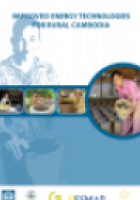Publications
Approximately 80% of Cambodians live in rural areas with limited access to clean and affordable water and energy. Furthermore, 34% of the rural population lives below the national poverty line on less than $0.60 per day. Many of these rural households use kerosene for lighting, “three stone stoves” for cooking, and water from rivers or ponds for drinking. Wood and charcoal are the primary energy sources, and almost all electricity is generated from imported diesel, both contributing to increased air pollution and deforestation. To address this situation, ASTAE, in collaboration with other donors, supported a program that focused on research and testing of new efficient, cleaner, and affordable energy technologies for wide dissemination.
World Bank. 2009. Improved Energy Technologies for Rural Cambodia. Washington, DC: World Bank. http://documents.worldbank.org/curated/en/570931468036882999/Improved-energy-technologies-for-rural-Cambodia
